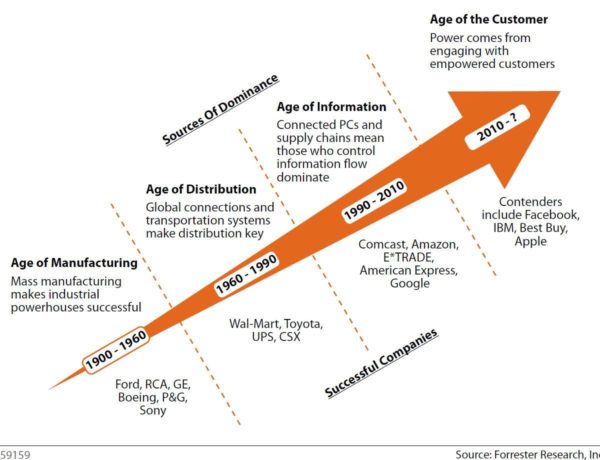As a company, where does your competitive advantage come from? Is it your manufacturing expertise, your broad distribution network? The team at Forrestor research studied this topic a few years ago and came to the conclusion that competitive advantage has shifted over time as our economy has changed. They created this graphic to explain the shift.

Manufacturing
In the first half of the 20th century, a company’s competitive advantage was gained on the manufacturing floor. Companies like Ford, Sony and P&G invested heavily in improving their process. They learned if they could build it faster and cheaper, they would win the battle for market dominance.
Standardization was the key. Customers could have any color car, as long as it was black. Consumers accepted their limited choices to have access to products at an affordable price.
Distribution
Things shifted in the middle of the century as consumers wanted access to a variety of products easily. Successful manufacturing companies realized their process didn’t end when product shipped out the door. The right distribution network could drastically reduce the final cost to the end user. Companies like Walmart and Toyota who figured out how to get products to market quickly and cheaply dominated the next 30 years.
Information
Then along came computers and the internet. Suddenly people discovered they could conduct research and actually buy on line. The shift happened quickly. As a marketing professor in 1998, I asked my students how many would be buying some of their Christmas gifts on line that year. Only a few raised their hands. The next year the majority indicated at least some of their purchases would be online. By 2011, most experts agreed Cyber Monday outperformed Black Friday.
In the age of information, successful companies used technology to improve their supply chain. In this era we saw the rise of Amazon and the fall of Barnes and Noble. Brick and mortar gave way to click and mortar as customers moved seamlessly between on and offline options.
The Customer
Today, customers are actively engaged in the sales process, whether you want them to be or not. The voice and power of customers drives the market, as peer reviews outpace company messages in terms of influence on future customers. Making the transition to the age of the customer will require companies to spend more resources listening to, engaging with and educating customers. Social media programs, inbound marketing and targeted newsletters are now basic elements of success, the way a “just in time” inventory management approach was 40 years ago.
In the era of the customer, size is not necessarily an advantage. Listening to and engaging with your customers is something any business, of any size can do. Perhaps small business owners even have an advantage. As more nimble organizations, we can adapt to changing customer demands, as long as we are listening.
The question : Are you listening?
More on Reviews from MixWest 2014
